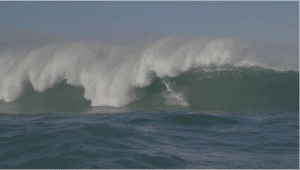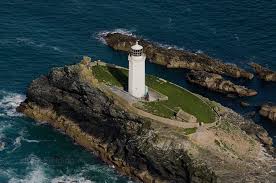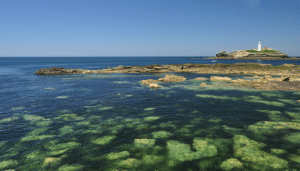Godrevy’s Infamous Stones Reef & Waves of Surfing History
St Ives Bay, located on the north coast of Cornwall, is a region of unparalleled natural beauty and geological significance. Within this stunning landscape lies Stones Reef, a surfing spot renowned for its challenging and often dangerous waves. This blog post delves into the rich history of how local surfers have mastered the notorious Stones Reef, while also exploring the fascinating geology of the Godrevy lighthouse and Stones Reef.
Early Days: The Birth of Surfing in Cornwall
Surfing in Cornwall began to gain traction in the early 20th century, inspired by the burgeoning surf cultures of Hawaii and California. By the 1960s, the sport had firmly established its roots along the Cornish coast, with Stones Reef emerging as one of the prime locations for thrill-seekers.
The 1960s and 1970s: Pioneering Spirit
The 1960s and 1970s were pivotal decades for surfing in Cornwall. Enthusiasts flocked to Stones Reef, attracted by tales of its formidable waves and pristine surroundings. Pioneering surfers like Rodney Sumpter and Bob Head played crucial roles in popularizing the reef. Their exploits, often documented in surf magazines and films, highlighted the unique challenges and rewards of surfing this treacherous spot.
The reef’s reputation was built on its powerful, hollow waves that demanded both skill and courage. Unlike the more forgiving beach breaks, Stones Reef required surfers to navigate sharp rocks and strong currents. Despite the risks, or perhaps because of them, it became a proving ground for local surfers.
Surf Competitions: Showcasing Talent and Tenacity
The 1980s and 1990s saw a surge in competitive surfing at Stones Reef. Events like the British National Surf Championships brought top surfers to the area, eager to test their mettle against the reef’s challenging waves. These competitions not only showcased individual talent but also fostered a sense of community among surfers.
Local surfers became known for their exceptional skills and deep understanding of the reef’s intricacies. They learned to read the waves, anticipate changes in conditions, and develop techniques to handle the reef’s hazards. This era cemented Stones Reef’s status as a premier surf destination and solidified the local surfing community’s reputation for excellence. Recently Surfers have surfed this Gornish Secret, those including the likes of International Big Wave Surfer Tom Butler. Watch the youtube video of them surfing the Stones Reef a few winters ago: WATCH

Modern Surf Culture: Respect and Conservation
Today, Stones Reef continues to be a beloved spot for surfers, both local and visiting. The surf culture here is vibrant and inclusive, characterized by a deep respect for the natural environment. Local surfers are passionate about preserving the beauty and integrity of the reef and its surroundings.
Environmental Initiatives:
Conservation efforts are integral to the local surfing community. Initiatives such as beach clean-ups, plastic waste reduction campaigns, and marine life protection programs are regularly organized. Surfers recognize their role as stewards of the environment and work tirelessly to ensure that Stones Reef remains a pristine and sustainable destination.
Surf Schools and Community:
Surf schools and clubs play a significant role in the community, offering lessons and fostering a spirit of camaraderie among surfers. These institutions teach not only the skills needed to navigate the reef but also the values of respect and conservation that are central to the local surf culture.
The Geology of St Ives Bay
Geological Formation: A Tapestry of Time
The geology of St Ives Bay is a fascinating tapestry woven from millions of years of geological processes. The area is characterized by a diverse range of rock formations, each telling a unique story of the Earth’s history.
Devonian Period: The Birth of the Landscape
The geological history of St Ives Bay begins in the Devonian period, approximately 400 million years ago. During this time, the region was part of a vast marine environment, with sedimentary rocks such as sandstone, shale, and limestone forming the bedrock of the area.
Variscan Orogeny: Shaping the Land
The Variscan Orogeny, a significant mountain-building event, occurred around 300 million years ago and dramatically reshaped the landscape. Intense tectonic activity led to the formation of folded and faulted rock structures, creating the rugged terrain that characterizes much of Cornwall today.
Granite Intrusions: The Cornubian Batholith
One of the most prominent geological features of the region is the Cornubian Batholith, a massive granite intrusion that stretches across Cornwall and Devon. The granite at St Ives Bay is part of this larger formation, created by the slow cooling of magma deep within the Earth’s crust. Over millions of years, erosion exposed these granite formations, contributing to the unique coastal features seen today.
Coastal Erosion: Nature’s Sculptor
The dynamic forces of coastal erosion have played a crucial role in shaping the landscape of St Ives Bay. The relentless action of waves, wind, and tides has sculpted the cliffs, beaches, and reefs, creating a constantly changing environment.
Stones Reef: A Product of Erosion
Stones Reef itself is a product of these erosive forces. The harder, more resistant granite and other rock types have withstood the test of time, while softer sedimentary rocks have been worn away. This process has created the jagged, rocky reef that challenges surfers and fascinates geologists.
Intertidal Zones: Rich in Life and History
The intertidal zones of St Ives Bay, the areas between high and low tide, are particularly rich in geological and biological diversity. These zones expose layers of rock that provide a window into the ancient past, revealing fossilized remains of marine life and other geological features.
Fossils: Echoes of Ancient Life
Fossil discoveries in the sedimentary rocks of St Ives Bay offer valuable insights into the region’s prehistoric marine environments. Fossils of brachiopods, trilobites, and ammonites are commonly found, providing evidence of the diverse life forms that once inhabited the area.

How Local Surfers Conquered Stones Reef
Understanding the Waves: Local Knowledge and Skill
The ability to surf Stones Reef successfully hinges on a deep understanding of its waves and unique conditions. Local surfers have honed their skills through years of experience, learning to read the subtle cues that indicate changes in wave patterns and currents.
Wave Dynamics: Power and Precision
The waves at Stones Reef are known for their power and precision. They break over the shallow reef, creating fast, hollow waves that require quick reflexes and precise maneuvers. Local surfers have developed techniques to handle these waves, including positioning themselves correctly, timing their takeoffs, and mastering the art of tube riding.
Seasonal Variations: Adapting to Change
Seasonal variations play a significant role in the surfing conditions at Stones Reef. During the autumn and winter months, the swells are larger and more consistent, providing the best conditions for experienced surfers. Spring and summer bring smaller waves, making it a more accessible spot for beginners and intermediates.
Safety and Preparation: Respecting the Reef
Safety is paramount when surfing at Stones Reef. The rocky reef and strong currents can pose significant hazards, making preparation and respect for the environment essential.
Equipment and Gear:
Choosing the right equipment is crucial for surfing at Stones Reef. High-performance surfboards designed for fast, powerful waves are preferred. Wetsuits are also essential, especially during the colder months, to protect against the frigid waters.
Surfing with a Buddy:
Surfing with a buddy is a common practice among local surfers. Not only does it enhance safety by ensuring help is available in case of an emergency, but it also fosters a sense of community and shared experience.
Legends and Stories: The Lore of Stones Reef
The history of surfing at Stones Reef is rich with legends and stories passed down through generations. These tales celebrate the achievements of local surfers and the unique challenges they have overcome.
Notable Surfers:
Figures like Rodney Sumpter and Bob Head are celebrated for their pioneering spirit and contributions to the local surfing culture. Their stories of conquering the waves at Stones Reef have inspired countless others to follow in their footsteps.
Epic Swells and Memorable Rides:
The lore of Stones Reef is filled with accounts of epic swells and memorable rides. Surfers recount their experiences of riding massive waves, navigating through the treacherous reef, and the exhilarating feeling of emerging from the barrel of a wave.

The Future of Surfing at Stones Reef
Preserving the Legacy: Education and Awareness
The future of surfing at Stones Reef depends on preserving its legacy and ensuring that new generations of surfers continue to respect and protect the environment.
Surf Schools and Training Programs:
Surf schools and training programs play a vital role in educating new surfers about the unique conditions at Stones Reef. These programs emphasise the importance of safety, environmental stewardship, and the rich history of the area. At Evolve Surf School we are so grateful to be perched on the edge of this unique and impecable stretch of coastline. Surf Lessons and Surf Equipment Hire are avaliable through our online booking forms.
Community Initiatives:
Community initiatives, such as environmental clean-ups and conservation efforts, are essential for maintaining the pristine condition of Stones Reef. These initiatives foster a sense of responsibility and pride among local surfers, ensuring that the reef remains a cherished destination for years to come.
Technological Advances: Enhancing the Experience
Technological advances in surfboard design, wetsuit materials, and wave forecasting have enhanced the surfing experience at Stones Reef. Modern equipment allows surfers to perform at their best, while accurate wave forecasts help them plan their sessions and stay safe.
Sustainable Practices:
Sustainability is a growing focus within the surfing community. Eco-friendly surfboards, biodegradable waxes, and sustainable apparel are becoming more popular, reflecting a broader commitment to protecting the environment.
The Role of Research: Understanding and Adapting
Ongoing research into the geological and environmental conditions at Stones Reef is crucial for understanding how to adapt to changes and preserve the area for future generations.
Climate Change and Coastal Erosion:
Climate change and coastal erosion pose significant challenges to the future of surfing at Stones Reef. Research efforts are focused on understanding these impacts and developing strategies to mitigate their effects.




